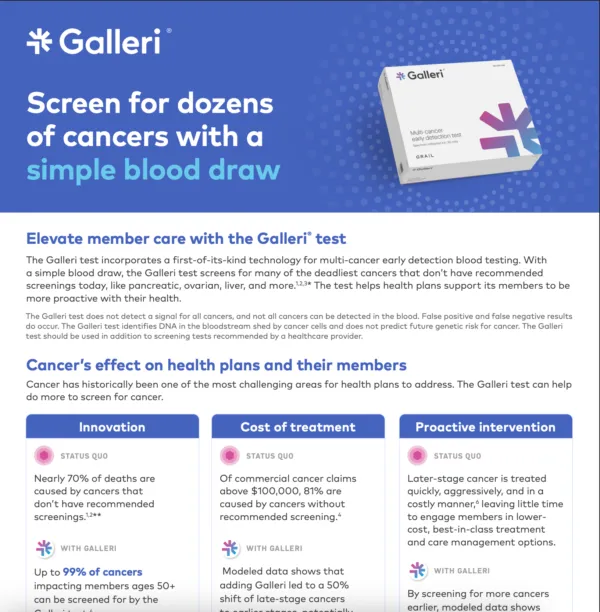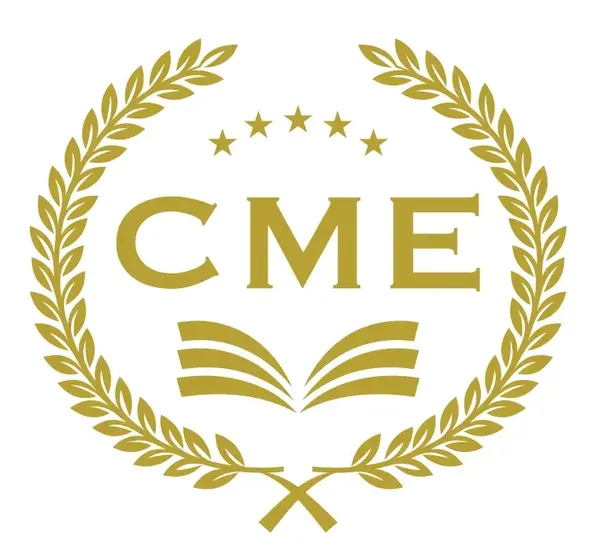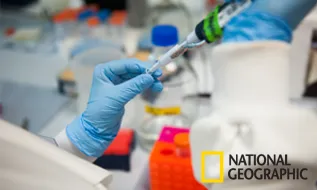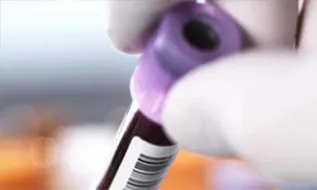Screen for a signal shared by 50+ cancers.
Galleri multi-cancer early detection screens for a signal shared by 50+ cancers with one blood draw, including cancers without a single-cancer screening.1,2
The Galleri test does not detect a signal for all cancers and not all cancers can be detected in the blood. False positive and false negative results do occur. The Galleri test should be used in addition to healthcare provider recommended screening tests.

The Galleri test does not detect a signal for all cancers and not all cancers can be detected in the blood. False positive and false negative results do occur. The Galleri test should be used in addition to healthcare provider recommended screening tests.
Screen members for more
The first of its kind, the Galleri test gives you the power to screen for a signal shared by 50+ types of cancer - all with a single blood draw.1
If a cancer signal is detected, the Galleri test predicts its origin with high accuracy to help guide the next steps to diagnosis.6
In the PATHFINDER study, Cancer Signal Origin (CSO) prediction accuracy was 88% for participants with a cancer diagnosis among study participants with "Cancer Signal Detected" test result.
The Galleri test does not detect a signal for all cancers and not all cancers can be detected in the blood. False positive and false negative results do occur. The Galleri test should be used in addition to healthcare provider recommended screening tests.

Connect with us to get started with the Galleri test
Download Galleri for Medicare Advantage Members Research
Elevate member care with the Galleri test.

Learn more about the Galleri test
Get started with Galleri
The Galleri test is recommended for use in adults with an elevated risk for cancer, such as those age 50 or older. The test does not detect all cancers and should be used in addition to routine cancer screening tests recommended by a healthcare provider. The Galleri test is intended to detect cancer signals and predict where in the body the cancer signal is located. Use of the test is not recommended in individuals who are pregnant, 21 years old or younger, or undergoing active cancer treatment.
Results should be interpreted by a healthcare provider in the context of medical history, clinical signs, and symptoms. A test result of No Cancer Signal Detected does not rule out cancer. A test result of Cancer Signal Detected requires confirmatory diagnostic evaluation by medically established procedures (e.g., imaging) to confirm cancer.
If cancer is not confirmed with further testing, it could mean that cancer is not present or testing was insufficient to detect cancer, including due to the cancer being located in a different part of the body. False positive (a cancer signal detected when cancer is not present) and false negative (a cancer signal not detected when cancer is present) test results do occur. Rx only.
The GRAIL clinical laboratory is certified under the Clinical Laboratory Improvement Amendments of 1988 (CLIA) and accredited by the College of American Pathologists. The Galleri test was developed — and its performance characteristics were determined — by GRAIL. The Galleri test has not been cleared or approved by the Food and Drug Administration. The GRAIL clinical laboratory is regulated under CLIA to perform high-complexity testing. The Galleri test is intended for clinical purposes.
- Klein EA, Richards D, Cohn A, et al. Clinical validation of a targeted methylation-based multi-cancer early detection test using an independent validation set. Ann Oncol. 2021;32(9):1167-77. DOI:https://doi.org/10.1016/j.annonc.2021.05.806.
- US Preventive Services Task Force Recommended Screenings
- Estimated deaths per year in 2022 from American Cancer Society Cancer Facts and Figures 2022. Available at: http://www.cancer.org/content/.... Data on file GA-2021-0065
- Reddy SR, et al. Cost of cancer management by stage at diagnosis among Medicare beneficiaries. Curr Med Res Opin. 2022;38(8):1285-1294. doi:10.1080/03007995.2022.2047536.
- Global oncology trends, 2019. IQVIA Institute for Human Data Science; 2019. https://www.iqvia.com/insights....
- Schrag D, et al. PATHFINDER: A Prospective Study of a Multi-Cancer Early Detection Blood Test. Presentation at European Society of Medical Oncology (ESMO) Congress September 9-13, 2022; Paris, France.
- Hubbell E, Clarke C, Aravanis A, et al. Modeled reductions in late-stage cancer with a multi-cancer early detection test. Cancer Epidemiol Biomarkers Prev. 2021;30:460-8. DOI: doi.org/10.1158/1055-9965.EPI-20-1134.
- Tafazzoli A, Ramsey SD, Shaul A, et al. The Potential Value-Based Price of a Multi-Cancer Early Detection Genomic Blood Test to Complement Current Single Cancer Screening in the USA. PharmacoEconomics. 2022;40(11):1107-1117. doi:10.1007/s40273-022-01181-3.








